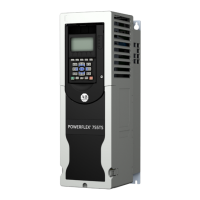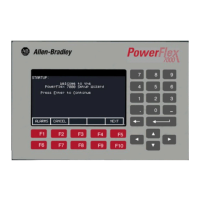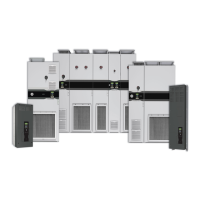Rockwell Automation Publication 20A-IN009E-EN-P - January 2015 7
PowerFlex 70 Adjustable Frequency AC Drive
Output Contactor Precaution
ATTENTION: The “adjust freq” portion of the bus regulator function is useful for
preventing nuisance overvoltage faults that result from aggressive
decelerations, overhauling loads, and eccentric loads. It forces the output
frequency to be greater than commanded frequency while the drive’s bus
voltage is increasing towards levels that can cause a fault; however, it can also
cause either of the following two conditions to occur.
• Fast positive changes in input voltage (more than a 10% increase within 6
minutes) can cause uncommanded positive speed changes; however an F25
“OverSpeed Limit” fault occurs if the speed reaches P82 [Max Speed] + P83
[Overspeed Limit]. If this condition is unacceptable, take theses actions;
1) limit supply voltages within the specification of the drive and,
2) limit fast positive input voltage changes to less than 10%. Without taking
such actions, if this operation is unacceptable, the “adjust freq” portion of the
bus regulator function must be disabled (see parameters 161 [Bus Reg Mode A]
and 162 [Bus Reg Mode B]).
• Actual deceleration times can be longer than commanded deceleration times;
however, a “Decel Inhibit” fault is generated if the drive stops decelerating
altogether. If this condition is unacceptable, the “adjust freq” portion of the bus
regulator must be disabled (see parameters 161 [Bus Reg Mode A] and 162
[Bus Reg Mode B]). In addition, installing a properly sized dynamic brake
resistor provides equal or better performance in most cases.
Note: These faults are not instantaneous and have shown test results that take
2...12 seconds to occur.
ATTENTION: To guard against drive damage when using output contactors,
the following information must be read and understood. One or more output
contactors can be installed between the drive and motor(s) for disconnecting
or isolating certain motors/loads. If a contactor is opened while the drive is
operating, power is removed from the respective motor, but the drive
continues to produce voltage at the output terminals. In addition, reconnecting
a motor to an active drive (by closing the contactor) could produce excessive
current that can cause the drive to fault. If any of these conditions are
determined to be undesirable or unsafe, wire an auxiliary contact on the
output contactor to a drive digital input that is programmed as “Enable.” With
the drive Enable input wired to the output contactor, the drive will coast-to-
stop (cease output) whenever the output contactor is opened.

